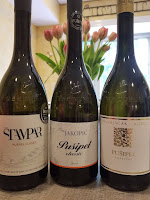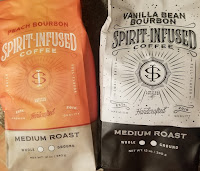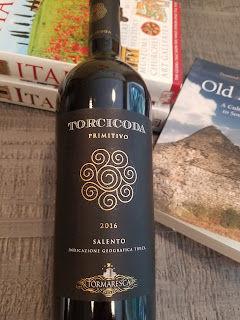In 1989 Jean-Michel Naud established the
Distillerie de la Tour and the
Famille Naud brand based out of a family distillery that had been repurposed from an old grain mill in 1923. This was the historic Cognac Distillerie Perrier located on the island of Pinthiers where Emile Perrier had crafted original liqueurs for decades. Famille Naud was able to resuscitate five very old traditional 2,500 liter Charente stills to produce a range of Cognacs and soon after to expand to become the first vodka distillery in Charentes.
 A recent Hopwine expo displayed the extent of more expansion as the kit included three cognacs (VS, VSOP & XO), a French still vodka, a distilled Gin, a 15-year-old Ron de Panama, and two Spiced Rum Hidden Loots. It also included two Pineau des Charentes - the special fortified wines of Cognac. All of these products were interesting, well crafted, and excellent representatives of their respective types.
A recent Hopwine expo displayed the extent of more expansion as the kit included three cognacs (VS, VSOP & XO), a French still vodka, a distilled Gin, a 15-year-old Ron de Panama, and two Spiced Rum Hidden Loots. It also included two Pineau des Charentes - the special fortified wines of Cognac. All of these products were interesting, well crafted, and excellent representatives of their respective types.
Cognac NAUD VSOP France - Charente-Maritime
NAUD VSOP cognac is a blend of Fins Bois, Bons Bois, and Petite Champagne (30%) that is double distilled in traditional small copper pot stills over direct flames then aged for a minimum of 4 years in oak barrels. Before bottling, older Eaux-de-vie (10 to 15 years old) are added to the cognac to add complexity and length. Expect dried fruit and baking spices on the nose with vanilla and orange added to the palate.
Cognac NAUD VS France - Charente-Maritime
NAUD VS cognac is made with a blend of two crus: Bon Bois and Petite Champagne (10%). The latter is aged in new oak casks which convey finesse and structure to the cognac. The Bons Bois imparts notes which are fruity (peach, pear) and floral (vine flower). The Eaux-de-vie is double distilled in traditional small copper pot stills and is aged separately, for a minimum of 2 years in small oak casks of 350 and 400L. The cognac is then aged a third year in larger casks in order to harmonize the flavors. Expect a more toasted profile with honey, vanilla, and peaches.
Cognac NAUD XO France - Charente-Maritime
The NAUD XO cognac is made with a blend of Petite Champagne, Grande Champagne and Fins Bois. Grande Champagne is the most prestigious cru in the Cognac region and is noted for the limestone where the vines are planted. This "conveys an incredible palette of flavors to NAUD XO cognac, where one can perceive the famous note of 'Rancio' (walnut, forest) so typical of extra old Cognacs". The youngest Eaux-de-vie within the NAUD XO cognac has been aged between 10 and 12 years. Older Eaux-de-vie (35 to 40 years old) is added before bottling to add even more complexity. Earthy, yet smooth with candied orange and baking spices, tobacco, and leather.
French Vodka NAUD France - Charente-Maritime
The NAUD Vodka is produced by fermenting French winter wheat that was grown northeast of Paris which is then distilled five times in a column still and then a sixth time in a typical Charentais copper pot still. Before bottling it is cut to proof using estate spring water that was naturally filtered through limestone grounds. The result is a deeply textured and incredible smooth vodka with no burn.
Distilled Gin NAUD France - Charente-Maritime
The NAUD Distilled Gin is produced using 12 botanicals which are first infused into the mash for 7-10 days and then distilled in a “vapor bain-marie” in small traditional copper pots stills. This is a complex gin, exploding with citrus, floral elements, tea, and spices before the juniper finally arrives at the finish.
Ron Naud Panamá 15 y.o Panama - Arco Seco
This Extra Old Rum is the result of a collaboration between Panamanian and Charentais Master Distillers united by Pierre Naud. The sugar cane was grown on the Peninsula de Azuero (Arco Seco), distilled, and then aged in American oak casks. A very complex rum with sweet honey, nuts, and vanilla.
Spiced Rum - Hidden Loot Original Panama - Arco Seco
This rum starts is distilled from molasses where the sugar cane was harvested from the Arco Seco region of Panama and then aged in Bourbon casks. Vanilla and sweet bananas are dominant with some honeyed nuts.
Spiced Rum - Hidden Loot Dark Reserve Panama - Arco Seco
This rum starts as a 2-year-old rum distilled from molasses in a column still where the sugar cane was harvested from the Arco Seco region of Panama. Then ten fruits and spices are added such as both sweet and bitter orange, coconut, vanilla, nutmeg, cinnamon, and bird chili pepper. The oranges are most prevalent followed by some toasted coconut and vanilla.
Pineau des Charentes - Reserve Or France - Charente-Maritime
Pinthiers Pineau des Charentes pays tribute to the distillery's ancestor, Emile Perrier, and is a 5 year cask aged blend of Cognac and grape juice ( Ugni blanc, Colombard, Sauvignon Blanc, Sémillon). This is an amazing fortified wine, dense with a floral nose, dried apricots, honey, candied fruits and nuts, and some baking spices.
Pineau des Charentes - Reserve Rubis France - Charente-Maritime
Pinthiers Pineau des Charentes pays tribute to the distillery's ancestor, Emile Perrier, and is a 5-year cask-aged blend of Cognac and grape juice ( Merlot, Cabernet Sauvignon). Another wonderful fortified wine marrying flavors of black fruit and cocoa with nuts and dried fruits.
 The name Plavac Mali is derived from the blue color of the berries (plavac) and the size of these berries (mali). An interesting phenomenon is that the berries on any particular cluster ripen at different times as evident from this slide courtesy of Volarević Winery. This forces the winemaker to make a difficult decision during harvest to obtain a sufficient balance between pH and sugars. This pushes harvest back until the end of September to early October.
The name Plavac Mali is derived from the blue color of the berries (plavac) and the size of these berries (mali). An interesting phenomenon is that the berries on any particular cluster ripen at different times as evident from this slide courtesy of Volarević Winery. This forces the winemaker to make a difficult decision during harvest to obtain a sufficient balance between pH and sugars. This pushes harvest back until the end of September to early October. 

















































